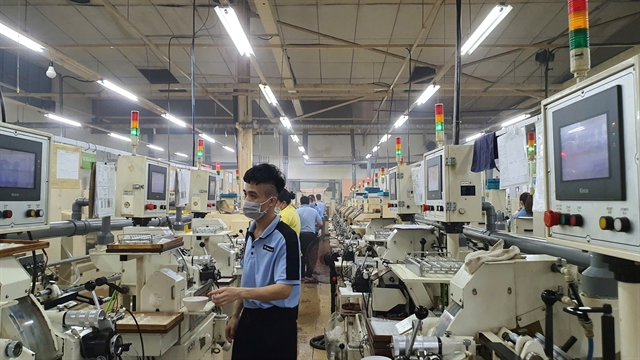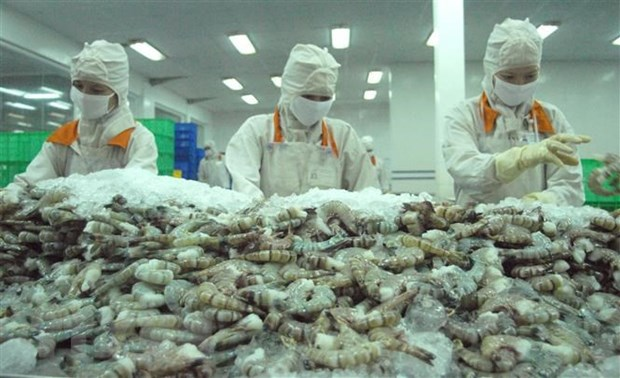.jpg) Economy
Economy

 |
| Workers at the processing plant of R Technical Research Vietnam Co., Ltd in Hoà Bình Ward, Phú Thọ Province. — VNS Photo Ly Ly Cao |
Ly Ly Cao
HÀ NỘI — Global supply chains are under unprecedented strain from pandemics, geopolitical tensions, extreme weather and rapid shifts in consumer demand. At the FIATA World Congress 2025 in Hà Nội on October 9, industry leaders and policymakers emphasised that agility and resilience must be the defining principles of modern logistics if businesses are to maintain continuity across sectors.
Deputy Chairman of the Singapore Logistics Association (SLA) Peter Lim reflected on lessons learned during the COVID-19 pandemic, when small, trade-dependent economies like Singapore experienced abrupt shutdowns that disrupted food, medical equipment and manpower supplies.
"We galvanised public and private infrastructure, created stockpiles and leaned heavily on digitalisation. It was a success, but also a supply chain shock with valuable lessons in resilience," one Singaporean representative recalled.
Participants agreed that resilience is not merely about building buffers but about designing systems that can pivot quickly. Agility – the ability to respond at speed and scale – must complement resilience’s defensive shield. Together, they safeguard critical sectors, from consumer goods and healthcare to manufacturing and agriculture.
Collaboration at the core
Many panellists underlined that collaboration remains the cornerstone of resilient supply chains, yet it is often impeded by cultural misunderstandings, institutional silos or entrenched bureaucracy.
Chairman and founder of World Cargo Alliance (WCAworld) David Yokeum recounted how a seemingly minor misinterpretation between Chinese and American partners led to the collapse of a potential deal, illustrating the fragility of cross-border cooperation.
Meanwhile, bureaucratic inertia in some markets continues to slow even simple supply chain adjustments.
"We've seen some large, fast-moving consumer suppliers taking 700 days to overcome their internal bureaucracy to get approval to change such a simple supply chain request," said Chief Supply Chain Officer of Central Retail Group Mike Reid.
Policy frameworks also play a decisive role in enabling resilience. Vice Chairman of the Vietnam Chamber of Commerce and Industry (VCCI) Nguyễn Quang Vinh highlighted that resilience is synonymous with competitiveness.
"Policies must create an enabling ecosystem for sustainable practices, circular economy adoption and digital transformation," he said. "In ASEAN, resilience is not just national. It's regional and global."
Extreme weather in Hà Nội just days before the congress provided a stark reminder of the urgent need for sustainability and adaptive capacity. From flooding to trade disputes, companies are operating in an environment of constant uncertainty. To thrive, governments and businesses must integrate ethical sourcing, corporate sustainability, and environmental, social and governance (ESG) practices into their supply chains, Vinh added.
Technology as shield and enabler
Technology is increasingly recognised as both a shield against disruption and an enabler of agility. Panellists highlighted how Internet of Things (IoT) devices, simulation models and artificial intelligence provide situational awareness, allowing businesses to anticipate risks and adapt strategies in real time.
"Agility gives us options, while resilience acts as a defensive shield," SLA Deputy Chairman Peter Lim said. "Technology links the two by forecasting disruptions and providing advance knowledge of what is to come."
At the same time, cybersecurity has become inseparable from supply chain resilience.
"There's no point in building something you cannot defend," Lim added, emphasising the need for stronger cross-border cooperation on digital and border security.
 |
| Speakers at the panel discussion on October 9. — VNS Photo Ly Ly Cao |
Air Cargo: Agility in Action
Air cargo was spotlighted as one of the most agile sectors in logistics. With global trade increasingly shaped by e-commerce and volatile demand, airlines have had to adjust networks quickly, often within days.
Director of Cargo Sales for North Eastern Asia at Turkish Cargo Ahmet Kürşat Baltacı said: "In a maximum of three days, we can create a new route."
This flexibility is possible because of large and diverse fleets, wide networks spanning 135 countries and partnerships across transport modes, he said.
Air cargo’s resilience is further reinforced by collaboration, with airlines increasingly sharing capacity and creating intermodal connections with sea, rail and trucking.
"In an unpredictable market, no one survives alone," Ahmet said.
Despite these advances, panellists cautioned against neglecting the fundamentals.
"We need to be brilliant at the basics," Mike said. "Before deploying AI forecasting or blockchain, companies must master warehouse flow rates, cost-per-case calculations and basic problem-solving skills. Too often, the basics are skipped, leaving organisations with weak foundations."
Education and continuous training are therefore essential. And Việt Nam’s young workforce, hungry for knowledge, is seen as a powerful asset in this regard. — BIZHUB/VNS


.jpg)

